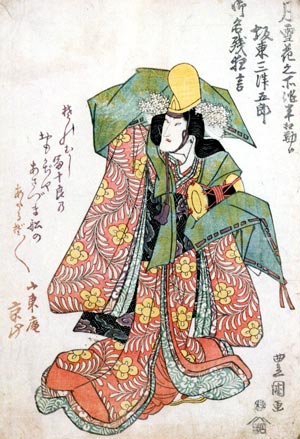| ASAZUMA BUNE |
| Dance title | Asazuma Bune Setsugekka Nagori no Bundai |
| Authors | Sakurada Jisuke II (lyrics) Kineya Sakichi II (music) |
| History |
The actor Band˘ Mitsugor˘ III performed in the 9th lunar month of 1820 at the Nakamuraza a 7-role hengemono, which was entitled "Setsugekka Nagori no Bundai". It was part of his onagori ky˘gen for he was about to depart from Edo to play in ďsaka. Three of these seven roles survived. One of these three roles, a prostitue dressed as a shiraby˘shi, became the independent dance "Asazuma Bune". |
| Key words | Shosagoto Nagauta Shiraby˘shi Asazuma Bune |
| Summary |
In the beginning of the dance, the performer is dressed as a court noble as she performs a dance of love between a Chinese emperor and his lover. The headwear is then taken off to change the direction of the dance. Next, the dance changes to a hand dance, which is then followed by a hand-drum dance. Then, the tempo is quickened by the beat of the bell and drum. The dances are tied together at the end by a fan dance. The unique feature to watch for in this dance is the way in which the various devices are cleverly woven into. The way in which the solemnity and the subtle nuances of the dance are expressed in the song and in the movement and skill of the performer is the special appeal of this piece. Source: Nihon Buy˘ |
 |
|
The actor Band˘ Mitsugor˘ III performing the "Asazuma Bune" section of the hengemono "Setsugekka Nagori no Bundai", which was staged in the 9th lunar month of 1820 at the Nakamuraza (print made by Utagawa Toyokuni I) |
|
|
| Contact | Main | Top | Updates | Actors | Plays | Playwrights | Programs | Links | FAQ | Glossary | Chronology | Illustrations | Prints | Characters | Derivatives | Theaters | Coming soon | News |